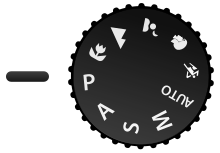Automatic programs
As automatic program a is automatic exposure control in automatic cameras referred to, in which the both exposure time of the shutter and the aperture value by the light metering are determined on the camera. Cameras that have automatic programs are also known as fully automatic machines .
function
The automatic program has replaced the program lock of older cameras.
Since the selection of the aperture / aperture combination always has to take into account the interaction between an optimal aperture for depth of field and the correct exposure time, many modern cameras are equipped with more than one automatic program. A “sports program”, for example, aims to select the shortest exposure time in order to reduce motion blur, while a “close-up program” selects the smallest aperture for the greatest possible depth of field.
Extensions
Most modern SLR cameras and compact cameras have a program automatic, but there are significant differences in the performance of these automatic systems. For example, the 35mm SLR cameras of the AF model series from Minolta, which were introduced in 1985 , have a microprocessor-controlled automatic program with automatic multi-program selection to wide-angle, standard and telephoto programs as well as program shift .
Multi program selection
When selecting a multi-program , the camera's automatic control automatically takes into account the focal length of the interchangeable lens attached to the camera and can then fall back on a specific wide-angle, standard or telephoto program. With a lens with a longer focal length (from 105 mm), for example, the camera switches to the telephoto program, which, if possible, selects a combination with a larger aperture and a shorter exposure time to prevent camera shake. The scope of these programs, which have already been considerably improved, have been considerably expanded in newer generations of cameras and nowadays attempts, for example, to use the movement of the main subject identified by the autofocus to determine whether it is a static or fast-moving object, and to continue the time / aperture combination accordingly adapt.
Program shift
A program shift is a function of manually intervening in the time / aperture combination determined by the automatic program and shifting its values, whereby, however, correct exposure is always maintained within the scope of what is possible in the current light situation. If the lighting conditions change, the automatic program takes this into account in its parallel shifted course.
If, for example, the values determined by the automatic program have been shifted by two exposure levels towards a shorter exposure time and a darker part of the subject is aimed at, the exposure time becomes longer again and the aperture is opened wider; In any combination, however, the exposure time remains two exposure levels shorter and the aperture two levels larger than in the time / aperture combination set by the camera.
